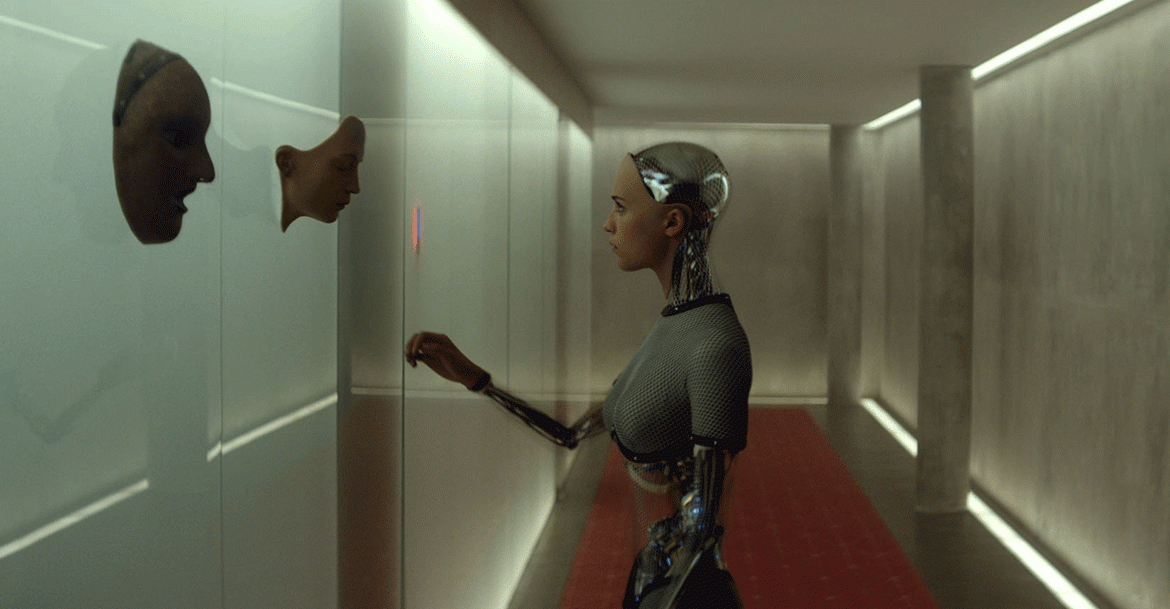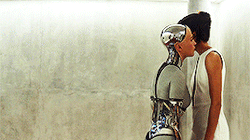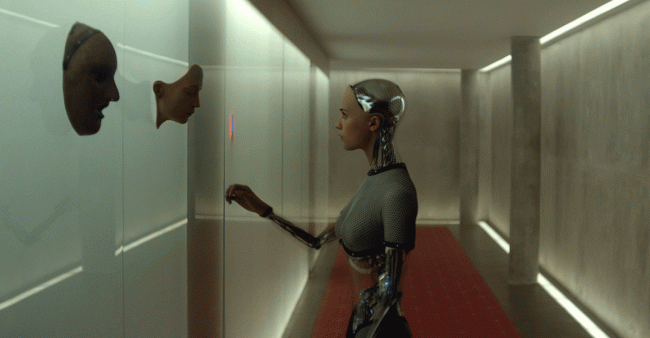On Robots as a Metaphor for Marginalization: The Stories We’re Not Telling
On Robots as a Metaphor for Marginalized Status

Who is your favorite fictional robot? Someone asked me this question recently and I realized that I didn’t have a good answer, other than “all of them.” Does it matter which one I choose, when all robot stories are so similar to one another?
Here’s how the story goes: society creates a robot. The robot is seen as “other,” set apart, and often cast in a servile role. The robot gets underestimated by humans. Perhaps the robot is a comical fish-out-of-water, and humans laugh at the observations of this “othered” being. Perhaps the robot begins to observe that society seems unfair, thereby making humans uncomfortable. Sometimes this results in polite but compelling debate. Sometimes, the robot chooses to assimilate and prove some internal sense of “humanity,” to assert their right to be the one robot in an all-human team. Sometimes, the robot rebells and initiates a rebellion against all humans. Throughout, the robot’s “other” status remains either a joke or a cause for discomfort or both, depending on whether it’s a comedy, an action-adventure, a drama, or a horror movie.
Much like how the mutants in X-Men serve as a catch-all metaphor for various forms of marginalization, so too do robots end up in that role. They most often serve this purpose in the stories that have a robot in a starring role; a story that is about a robot will generally also be a metaphor for oppression.
Even when robots are side characters, their role as servants is still a big part of what defines them, but when they’re side characters, this isn’t supposed to alarm or unnerve us. In Star Wars, for example, the robots definitely play a classic servile role, but several of them seem more like endearing puppies who deliver newspapers, or polite butlers serving a tray of tea.
The “puppy” type and the “butler” type appear many times across fictional media as well as in real life. These robots, who are also generally coded as masculine, live to serve us and flatter our notions of being “in charge.” If a robot character like this appears in a science fiction story as a side character, the chances are good that this robot will never end up rebelling. This type of robot is flattered that humans even deign to hang out with them, and can’t wait to work for the humans. They will serve as a comic relief of sorts; their “robot” status will allow us to mentally categorize them as “other,” and make it okay for us to laugh at their errors.
This starts getting weird as soon as we remember that “robot” is also often used as a metaphor for some form of marginalization. Depending on the story, the “robot” status could serve as a metaphor for classism, racism, sexism, queerness, or any number of other markers of “otherness.” But even without that metaphor, the story of the robot speaks to a generic human experience – the idea that society has “programmed” us to behave, to listen, to obey authority figures. The romantic notion that we might be able to reverse our own programming and break free from the system appeals to us all. It helps, also, that usually the “robot” character exhibits a particular sort of power fantasy: the robot turns out to be smarter than their human creators, and more clever, and perhaps even physically stronger than anyone imagined. We underestimated the robot, we laughed at the robot, we made the robot fetch the paper … and now they’re going to killlllll.
But these rebellious robots are not necesasrily the robots that we like. In a very informal poll on my own Twitter, I asked people to name their favorite fictional robots. I was expecting more people to name the dangerous free-thinking robots who sprang to mind for me. Instead, by and large, I got a list of robot butlers, robot puppies, and robot friends.
I did hear some exceptions, though: one person said Number 6 from Battlestar, another said GlaDOS from Portal, and one person said Cindi Mayweather, who is the fictional robot who Janelle Monae has created for the world in which her music takes place (which is, of course, rife with metaphor and social commentary). But many people listed robots who could easily fall into these three loose categories:
Butler Robot (e.g. C-3PO, Jarvis): Smart but servile. Not the rebellious sort, beyond the occasional sarcastic quip. Usually coded as male.
Puppy Robot (e.g. R2-D2, Wall-E, H.E.L.P.E.R.): Servile. Some overlap with the “Butler” archetype here, depending on how smart the robot is. It’s mandatory that the Puppy Robot be cute. Usually coded as male. (Dogs are a man’s best friend, after all.)
Friend Robot (e.g. Data, Sonny, The Vision): This robot may still be seen as an outsider and “other” according to humans, but their journey is ultimately one of assimilation. The fact that the robot can “hang” with humans is celebrated. Often this type of character is either played by or voiced by a white man. The only marker of “other” is the fact that, in the story, they are a robot. Usually, a superhero team has only one robot … unless the entire team is robots, in which case one of those robots will be female.
Villain Robot (e.g. Ultron, Terminator): Smart. Designed to be servile, initially, but has soon learned otherwise. Hates humans. Likes to say “Kill all humans.” Usually coded as male …
And then, there’s The Robot Who Is A Lady, which really deserves to be its own classification. If she ends up fitting into any of the above categories, beyond just being a Lady Robot, they’re most likely to be Villain Robot.
The Lady Robot has multiple designations of “other” by virtue of the fact that she is a robot and also a lady, which means her story will also be a metaphor for gender politics. In the case of Cindi Mayweather, that story will also be about the intersection of race and gender; the robots in Janelle Monae’s work serve as a multi-faceted metaphor for various lenses of oppression. Similarly, the stories in Portal and Ex Machina are nominally about “robot rights,” but also implicitly about gender politics. The fact that Number 6 is the face of the Cylon revolution in Battlestar, and that much of her story revolves around her betraying and deceiving a human man who loves her, epitomizes the way the Lady Robot’s story tends to operate.
Like the male “Robot Friend” characters, the Lady Robot has to fight to be seen as a human – but, on top of that, she has the added layer of disrespect that comes from being a woman, and potentially also a black woman (as with Cindi Mayweather). She is also seen, by default, as a sex object.
EDI from Mass Effect seems to fit more closely into the “Robot Friend” designation, alongside The Vision and Data; like many robots of this designation, she ends up dating a human, and her assimilation into human society is painted as a good thing rather than a loss. The “Robot Friend” story often revolves around the robot finding a way to become as similar to humans as possible, and proving their worth to humans. This is pretty sad when you think about the implications beyond the metaphorical framing, though, since it suggests that the people of “othered” status need to assimilate as well, rather than that the people around them should adapt to them. Why don’t any of the “Robot Friends” have any, y’know, robot friends? As soon as robots start hanging out with one another, the story becomes one about rebellious, free-thinking Villain Robots. Says a lot about how we see marginalized people, hm?
 (image via Tumblr)
(image via Tumblr)
Meanwhile, Rosie from The Jetsons is one of the few female robots I can think of who embodies the “Robot Butler” concept. She isn’t also seen as a sex object or even as an equal to the human characters, in part because she is not drawn as conventionally attractive, and also she wears a maid outfit that is so old-fashioned in its design that it also makes her seem much older than the human characters. By contrast, the actual design concepts for real-life robot maids are clearly inspired by Rosie, except they’re all unanimously given a slim hourglass shape, rather than the boxy frame that Rosie has. What’s more, a lot of these robots still wear the exact same clothes that Rosie did, except more sexualized (shorter skirt, etc). Even though the source material of The Jetsons doesn’t sexualize Rosie, she has been sexualized in her legacy, because apparently we can’t imagine a female robot having a non-sexual status. (This problem, again, doesn’t come up with male robots, who can exhibit the whole range of differences in this area.)
I think that’s why so many of our Lady Robot stories revolve around a sense of guilt. On some level, we do know that it is wrong to objectify people, but with a robot, it feels “safe” to treat them like an object … because, ideally, they’re never going to mind. If they DO start to mind, that’s when the horror story begins for us. Ironically, this doesn’t seem to come up in quite the same way with our male fictional robots; we seem to give them a lot more room for various forms of characterization, perhaps because the male robots are never also seen as sex objects.
There’s a wealth of research about how, in real life interactions with robots, people will treat the robots with female names more rudely than their male counterparts. Even if those robots have identical programming and dialogue, people will perceive the female robots as less competent, and will also defend their right to be rude to female-coded assistive robots like Cortana and Siri. This leads to some excellent “underdog” stories in the world of the fiction that we create, in which robots rise above their station and reject the world that undermines them.
The part that makes me feel sad, though, is that this role is apparently the only one that we can imagine for a fictional female robot. The idea that The Force Awakens‘ BB-8 might be a female robot was a cause for hilarious jokes and playful “debate” at the time, but it’s also a fair question. Why do we gender robots as male by default? And if their gender is marked as “other” than male in any way, then why does their entire story suddenly become about that – and why are they also instantly sexualized, too? Heck, why do we even feel the need to give robots a gender at all? There’s no logical reason why robots would even have that concept. Except that even imagining a robot that doesn’t conform to our own notions of gender stereotypes is, apparently, impossible for us to do.
To clarify, I actually do like the fact that stories about robots are also metaphorical stories about marginalization. But I think they could stand to be less reductive in terms of this framing, and go beyond just the most basic metaphor. For example, I’ve been reading all of Marvel’s old story-lines about The Vision, and I’ve become enraptured by the way his story navigates all of the different influences at work in his brain: his sense of humanity, his robot logic, Ultron’s influence on his inner-workings, his love for his friends and his respect for them, his desire to have a “normal” picket-fence life with Scarlet Witch, which then runs up against his desire to save the world and be a hero, and his struggles with balancing that all of these intruding anxieties. He’s a character that I relate to a lot, but it’s also hard for me to imagine a female robot character having as much nuance and depth as The Vision in these early comics, because once that additional layer of “other” gets added to a character, it’s as though writers can no longer see past it.
The Vision being a robot already gives him one layer of “other,” which means that he has more permission to go against stereotypes about what a male hero would do. This means that The Vision can navigate questions like, “Can I really have it all?” It’s rare to see a male superhero worrying about how to balance his work life and his family life; that’s often framed as a uniquely female problem, as silly as that is. Since The Vision is also framed as a white straight man (when he projects a picture of how he would see himself as a human, he creates a white guy), he’s therefore seen as inherently more relatable, because he’s only one step away from the assumed “default.” His robot identity is the only “other” aspect of him, and that means the reader will already humanize him. (I realize the irony of using the word “humanize” here.) However, he also serves as a sort of example case for “what it would be like to be different” – except without him ever having to be that different.
The Vision’s robot status allows the (presumed male, presumed white, presumed straight) reader to have a metaphor for what it might be like to be marginalized … but it keeps the metaphor simple, and doesn’t invite the reader to question what this world might really be like for different types of robots who aren’t as “typical” as The Vision. What about a robot who can’t assimilate as easily as The Vision has done? What is their story like?
The Vision’s tale still makes for a compelling read, of course; I just told you all how much I enjoyed it. But it also still means that any fictional story about mutants who are marginalized in other ways ends up becoming confused about how to navigate the problem of telling a story that navigates how complicated those intersections would be, within that fictional world. Ms. Marvel is one of the only examples that I can think of when it comes to a story that actually addresses the fact that a teen female superhero of color would face a unique set of challenges and biases from the world around her.
This seems to be an inherent problem with science fiction metaphors for marginalization, across the board. Because the metaphor of “alien” or “robot” or “mutant” can serve as a catch-all for any form of marginalization, and so often does, the results can also be reductive and oversimplistic if the writer isn’t careful. It probably seems easier for writers to just have the hero be a “default” of white straight male, and then slap on that they are also an alien (e.g. Spock, Superman). That way, the reader can envision that “other” status as representing any form of marginalization that they so choose, therefore making this straight white male accessible to a presumed “everyone”. Except that this doesn’t really work, because not all forms of marginalization are the same, and different biases exhibit differently. Also, it means that writers get more of a pass when it comes to presenting a story about marginalization, because they don’t have to do any real research; any missteps they make can be written off as, “Oh, well, that’s just because it’s how things are for aliens.”
This allows writers to take lazy shortcuts when it comes to presenting the actual experience of being othered, in real life. There is no anti-mutant bias in real life, therefore the writer can allow it to exhibit however they want, or pick and choose whatever real-life events they feel like including with seemingly no risk of offending anyone. But then the reader is left questioning: how would all of our history have changed, if this additional intersection of oppression (being a mutant, or an alien, or a sentient robot) also existed and affected the way we see one another? How would it feel to be a mutant and also Asian, to be an alien and also gay, to be a robot and also a woman and also gay and also black?
In each case, the story that I often end up reading is just, “here’s how it would feel to be a robot,” even if that robot is also of some other marginalized status. Very few robot stories deal with the real problem of how robots that do not read as male would be treated differently, nor how robots who do not read as white would be treated differently, and so on. Instead, as in Ex Machina, the problem gets skipped over entirely; every human in Ex Machina is male, every robot is female. Therefore the gender politics of the movie remain simple, in theory, but the movie’s racial politics fail as a result, thanks to this reductive framing that only acknowledges gender and expects the viewer to take no notice the fact that half of its four-person cast isn’t white (and that, spoiler, the two non-white characters end up dead). Ex Machina seems only equipped to deal with one metaphor. Beyond that, and it would simply be too complicated.
Maybe what I’m asking for here is too complicated. But a good writer should love a challenge, right? Surely we can come up with a less reductive way to tell robot stories than this. Or perhaps we’ll have to build a robot just to create one.
(Featured image via DNEG)
—The Mary Sue has a strict comment policy that forbids, but is not limited to, personal insults toward anyone, hate speech, and trolling.—
Follow The Mary Sue on Twitter, Facebook, Tumblr, Pinterest, & Google+.
Have a tip we should know? [email protected]
